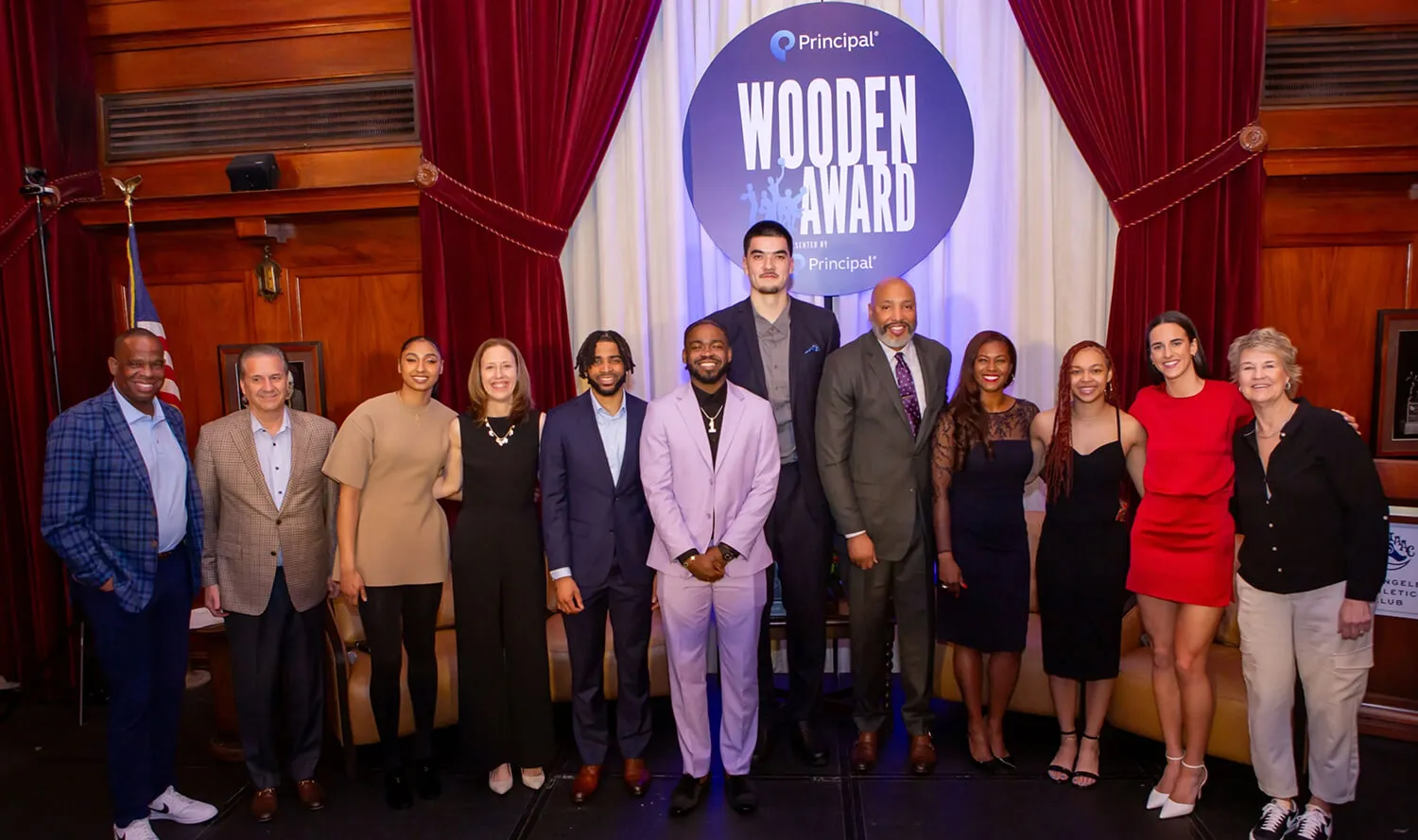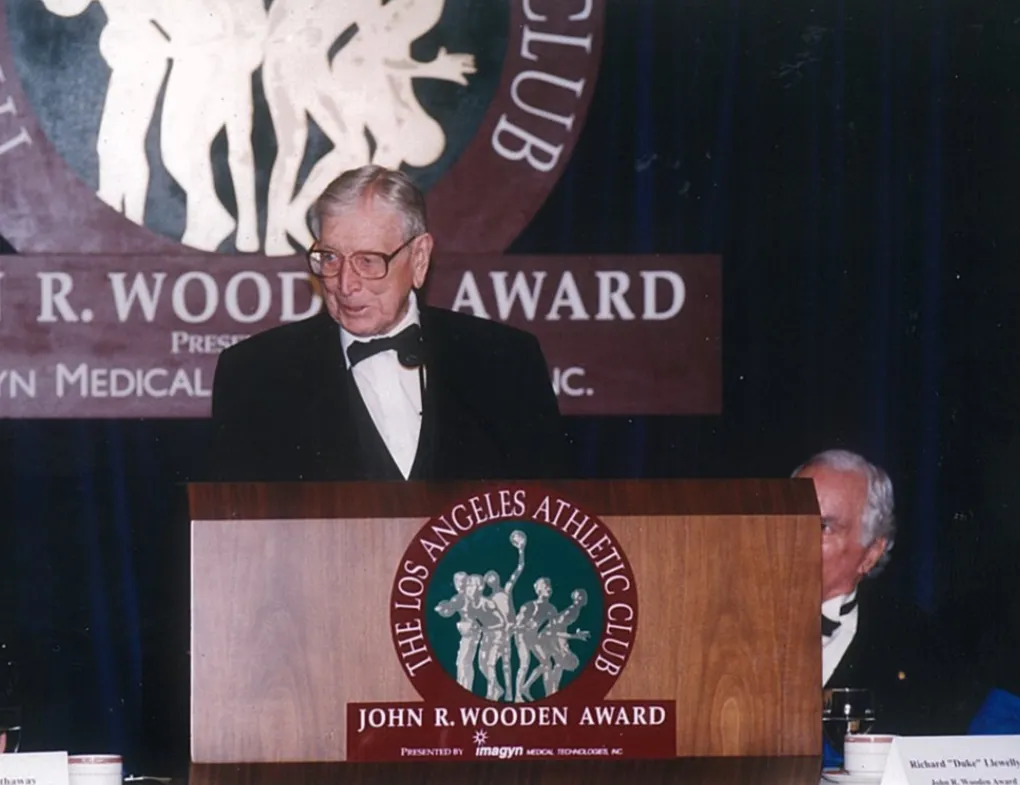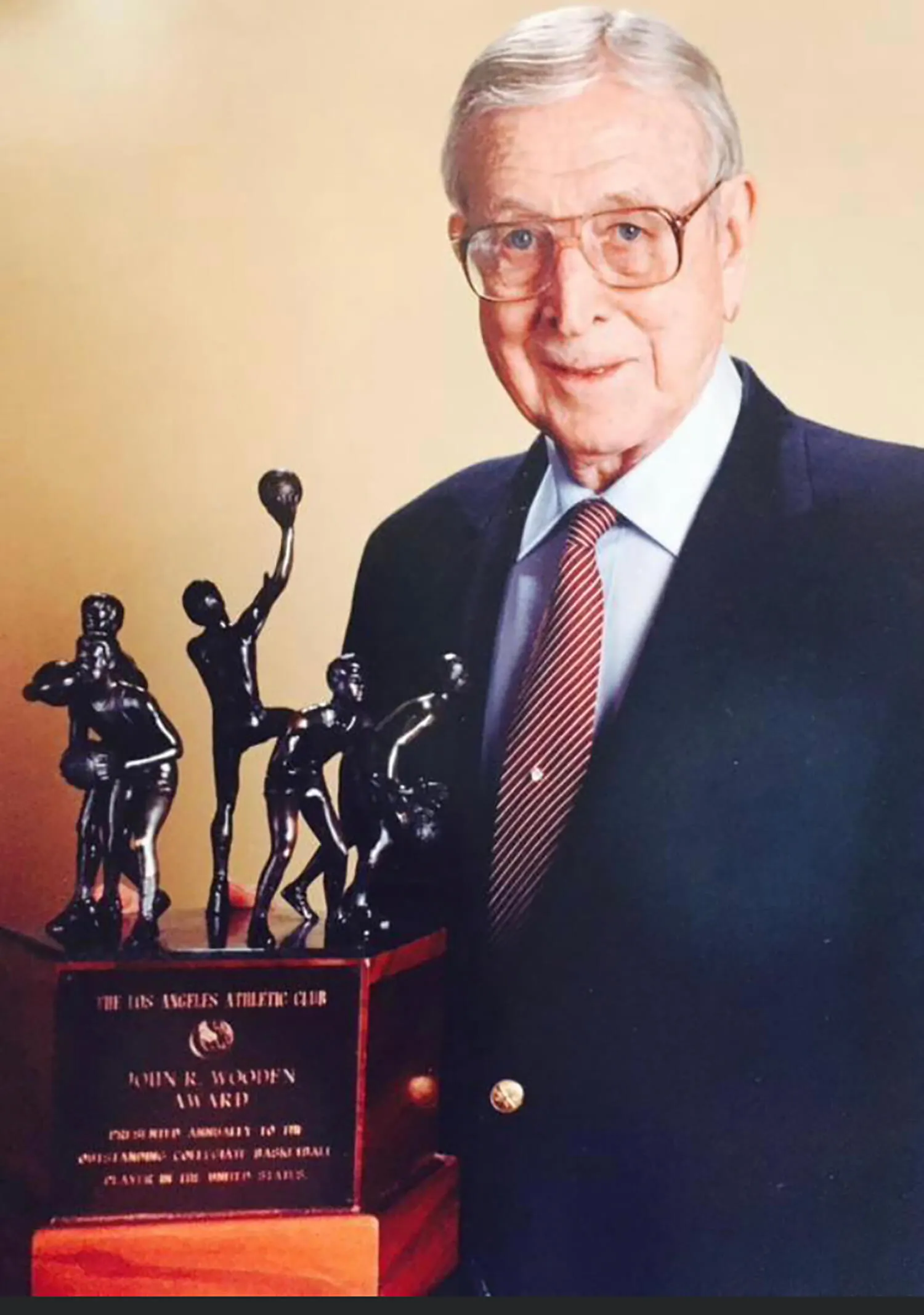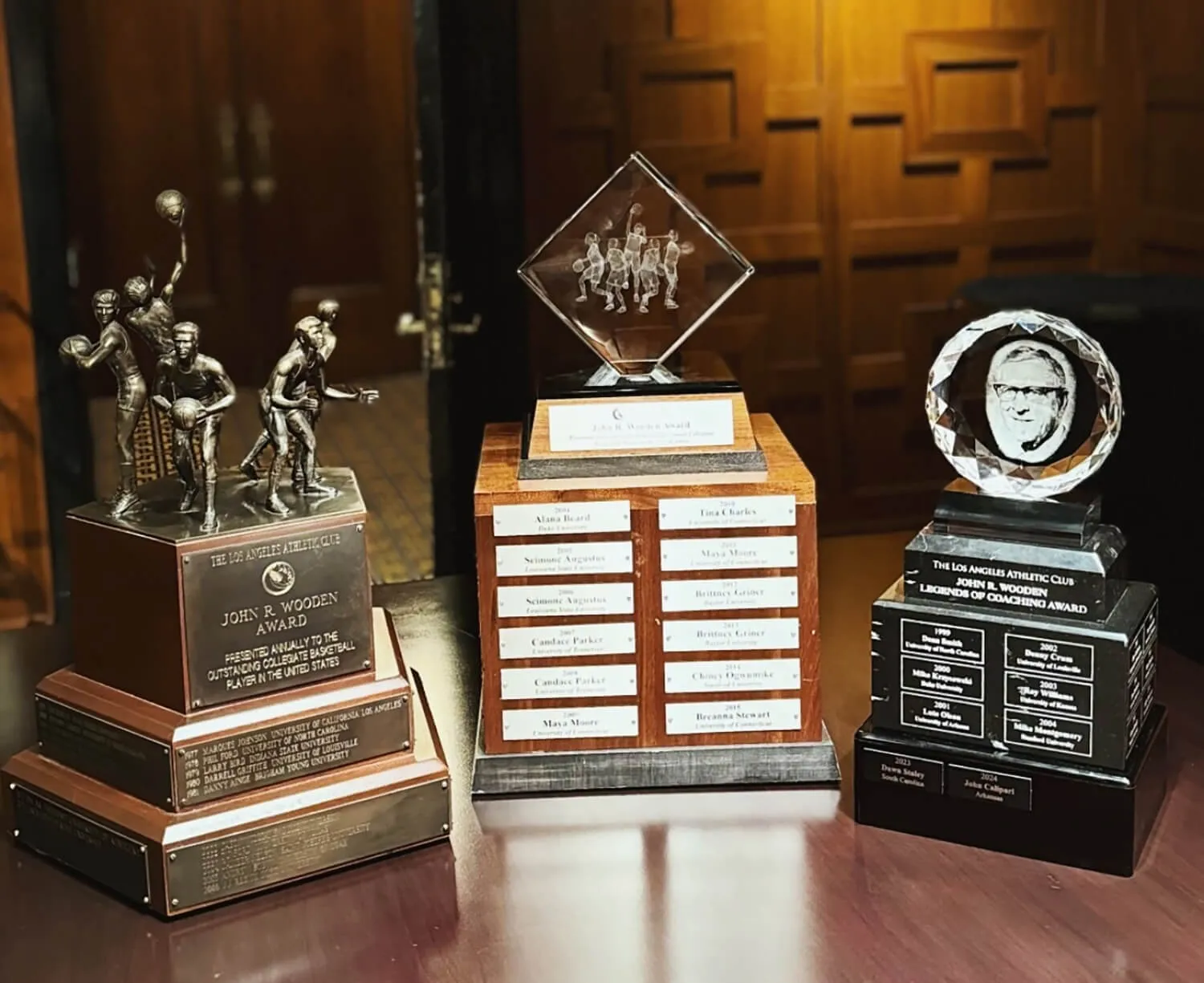About

About The Awards
The John R. Wooden Award is presented annually to the outstanding collegiate basketball Player of the Year for both men and women. Candidates for the award are selected by a panel of college basketball experts from across the 50 states. The National Advisory Board seeds the national ballot, which includes top candidates who meet the award’s criteria, such as being a full-time student with a minimum 2.00 GPA, contributing to team effort, and excelling in both offense & defense and exhibiting character. Voters, over 1,000 basketball media experts, evaluate players based on their performance throughout the entire season, including the NCAA Tournament. The All-American teams are announced the weekend of the “Final Four,” and the Player of the Year is awarded a five-figure bronze trophy at a gala in Los Angeles.
The Men’s Wooden Award was established in 1975 and first presented in 1977. The Women’s Wooden Award, established in 2004. Candidates for both awards must meet the same academic and performance criteria. Perpetual versions of the trophy are displayed in the Basketball Hall of Fame and the Los Angeles Athletic Club.
The Wooden Award National Chairman have been founder Duke Llewellyn (1975-2010), Tommy Hawkins (2010 to 2017) and Sam Lagana (2010 to present). The award was founded at The Los Angeles Athletic Club in Los Angeles, CA and continues to be administrated from LAAC.


The Legacy of John R. Wooden
Coach John R. Wooden was an exceptional player and coach, known for his remarkable achievements both on and off the basketball court. As a player at Purdue University from 1929 to 1932, he was a standout, earning All-American honors and leading his team to the NCAA championship in 1932. Later, as the head coach at UCLA, he built an unprecedented legacy, winning 10 NCAA championships, including seven consecutive titles from 1967-1973. Known for his “Pyramid of Success,” Wooden focused not only on basketball skills but on building character, teamwork, and discipline, instilling in his players the importance of both athletic and academic excellence.
The John R. Wooden Award was created in 1976 to honor the best collegiate basketball players, male and female, and to reflect the values that Coach Wooden championed. The award was designed to recognize players who excelled not only in their basketball performance but also in their character, integrity, and academic achievements—principles that were central to Wooden’s coaching philosophy. Today, the Wooden Award continues to uphold his legacy, celebrating athletes who embody the same qualities of excellence and leadership that made Coach Wooden a revered figure in sports.


About the Trophy
The John R. Wooden Award Trophy is handcrafted using the original molds from 1975. The trophy features five bronze figures, each representing one of the five major skills that John Wooden believed a “total” basketball player must exhibit: rebounding, passing, shooting, dribbling, and defense.
The concept for the trophy originated with Founding Wooden Award Chairman Richard “Duke” Llewellyn. Work began on the trophy in 1975, and sculptor Don Winton, who had designed numerous prestigious sports and entertainment awards, including the Grammy, was entrusted with creating the model. The trophy continues to be handcrafted in the western foothills of the Rocky Mountains by artisans trained in Don Winton’s methods. The figures are bronze-plated and mounted on a pentagonal base plate. The tallest figure, representing shooting, stands at 10 1/4 inches (26 cm). The trophy’s solid walnut base measures 7 1/2 inches (19 cm) in height, bringing the total height of the trophy to 17 3/4 inches (45 cm), with a total weight of 25 lbs (11 kg).
The Women’s Wooden Award Trophy, introduced in 2004, features a crystal top with the five figurines adopted by the Wooden Award, symbolizing the award’s history and its intent to honor complete basketball players, just as the original trophy did. The base is made of painted wood, with the crystal top mounted above and the five figurines depicted in three dimensions to represent the well-rounded female basketball player.
The Legends of Coaching Award consists of a crystal piece etched with the image of Coach John Wooden, mounted on a black marble base with a plate commemorating the honored coach, their school, and the year of presentation.
The Wooden Award All-American Team Trophy is a glass pyramid featuring the Wooden Award’s five-figure logo etched into the glass and mounted on a marble base. A plate affixed to the base honors each All-American by name, school, and year of the award presentation.



The Pyramid of Success
The Pyramid of Success, created by Coach John Wooden, is a framework for achieving personal and team excellence. It consists of 15 key qualities that are arranged into a pyramid, with industriousness and enthusiasm at the base as foundational elements. Above these are qualities like self-control, alertness, and initiative, which build on each other. At the top of the pyramid is competitive greatness, representing the ultimate goal of performing at your best when it matters most. Throughout the pyramid, values like loyalty, team spirit, friendship, and patience emphasize the importance of character, teamwork, and resilience in both sports and life.
“A good coach can change a game, a great coach can change a life”
John R. Wooden Foundation & Board
The John R. Wooden Award Foundation (JRWAF) is a non-profit 501(c)(3) organization, established in 2023 and chartered in 2024, dedicated to supporting and promoting the John R. Wooden Award programs nationwide. Its mission is to foster teamwork, academic excellence, and character development. JRWAF serves as the primary resource provider for the Wooden Award’s legacy and philanthropic efforts while offering comprehensive guidance and support for award administration, ensuring integrity and adherence to John Wooden’s principles. Board members actively engage in development and fundraising efforts to support JRWAF’s mission. The Board meets at least six times a year and files a Form 990 with the IRS. Since its inception, the John R. Wooden Award® program has made charitable gifts of nearly one million dollars in the names of the Wooden Award All American recipients and has sent more than 1,000 underprivileged children to week-long college basketball camps. The Special Olympics of Southern California holds a special place in the hearts of the Wooden Award activities, as Chairman Sam Lagana introduced the program in 1996 that integrates the Wooden Award All America Team with teams from Southern California Special Olympics in basketball competition when the student athletes and their coaches, coach the SOSC athletics in competition at LAAC.
JRWAF Board of Directors:
Sam Lagana – Founding Chairman
Tetsu Tanimoto – Vice Chairman
Stewart Hsieh – Secretary
Sean Rooney – Treasurer
Linda Reid
Bill Doak
Greg Wooden
Craig Impelman
Upen Sachdev
Steering Committee
Established in 1975, the John R. Wooden Award Steering Committee is dedicated to supporting the award’s activities at the Los Angeles Athletic Club, providing strategic advice and guidance on Wooden Award programs. Members contribute to various aspects of hosting the Wooden Award Weekend and assist in securing financial support for the event. The Steering Committee meets three times a year.
Sam Lagana – Chairman
Tetsu Tanimoto
Stewart Hsieh
Bob Merritt
Sean Rooney
Linda Reid
Bill Doak
Greg Wooden
Craig Impelman
Anne Myers Drysdale
Brian Takao
Chris Hooks
Marcus Tanimoto
Josh Hsieh
Jessica Campbell
National Advisory Board
Established in 1976, the John R. Wooden Award Advisory Board is responsible for overseeing the annual selection of candidates for the three seasonal watchlists and final ballot. Two National Advisory Boards (NABs)—one for men and one for women—ensure the integrity of the selection process by recognizing complete basketball players who contribute to their teams while demonstrating strong character. This distinguished group of advisors provides the list of nominees for the 1,300 voters who determine the ten-person Wooden Award All-America Teams and the two honorees for Most Outstanding Collegiate Basketball Player in the United States.
About Special Olympics:
The John R. Wooden Award® partners with the Special Olympics Southern California (SOSC) each year to host the Wooden Award® Special Olympics basketball day. The event brings together Special Olympics athletes and Wooden Award® All America Team and coaches in attendance. It is hosted at the Los Angeles Athletic Club during the John R. Wooden Award® Weekend.

Legends of Coaching
The Legends of Coaching Award was adopted by the John R.Wooden Award Committee in 1999. North Carolina’s Dean Smith was the first recipient of the award in 1999, followed by Duke University’s Mike Krzyzewski in 2000, the University of Arizona’s Lute Olson in 2001, the University of Louisville’s Denny Crum in 2002, the University of North Carolina’s Roy Williams (was coaching at the University of Kansas when he received the award), in 2004 from Stanford University, Mike Montgomery, the University of Connecticut’s Jim Calhoun and the latest addition from the University of South Carolina, Dawn Staley.
The Award recognizes the lifetime achievement of coaches who exemplify Coach Wooden’s high standards of coaching success and personal achievement. When selecting the individual, the Wooden Award Committee considers a coach’s character, success rate on the court, graduating rate of student athletes, his coaching philosophy and his identification with the goals of the John R. Wooden Award.

ABOUT PRINCIPAL FINANCIAL GROUP
Principal is presenting sponsor of the John R. Wooden Award for women and men and the Legends of Coaching Award. As a company committed to helping more people and businesses make financial progress, we are proud to support this annual celebration of expertise, excellence, and equality in basketball. The Wooden Award offers a unique opportunity to pair the shared values of Coach Wooden and Principal to recognize the outstanding women, men, and coaches who are elevating today’s game.

“Failure is not fatal, but failure to change might be”

ABOUT The Los Angeles Athletic Club
The Los Angeles Athletic Club (LAAC) has been closely tied to the John R. Wooden Award since its founding in 1975 and the first presentation in the 1976-77 season. The LAAC hosts the annual Wooden Award presentation ceremony and is home to the official Wooden Award trophy, which was designed by Duke Llewellyn, a close friend of Coach Wooden. The trophy symbolizes Coach Wooden’s principles, featuring five figures representing key basketball skills. The LAAC also hosts the Wooden Award Gala, where the Player of the Year is honored. Additionally, the LAAC displays Wooden Award memorabilia, solidifying its role as the heart of the award’s history and legacy.

